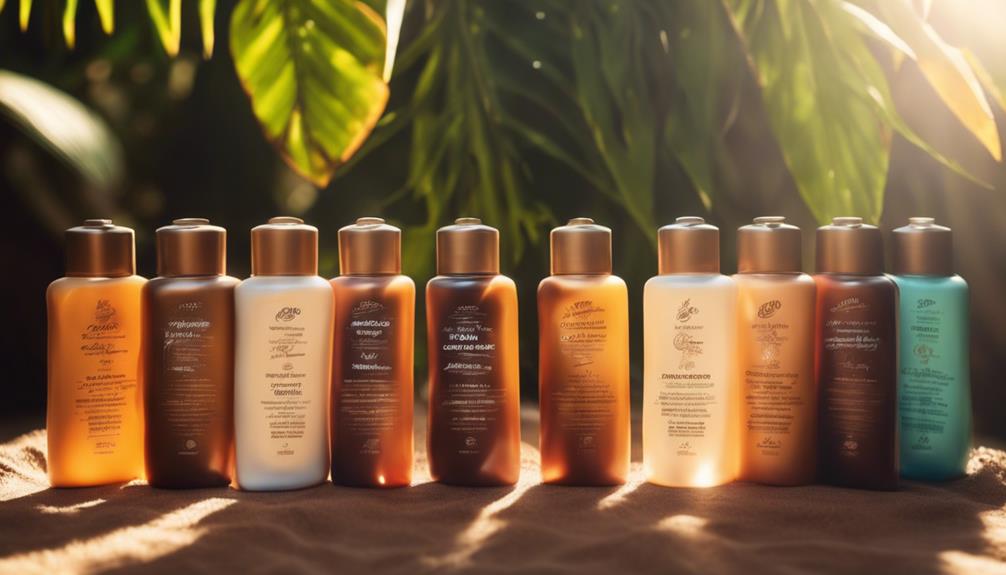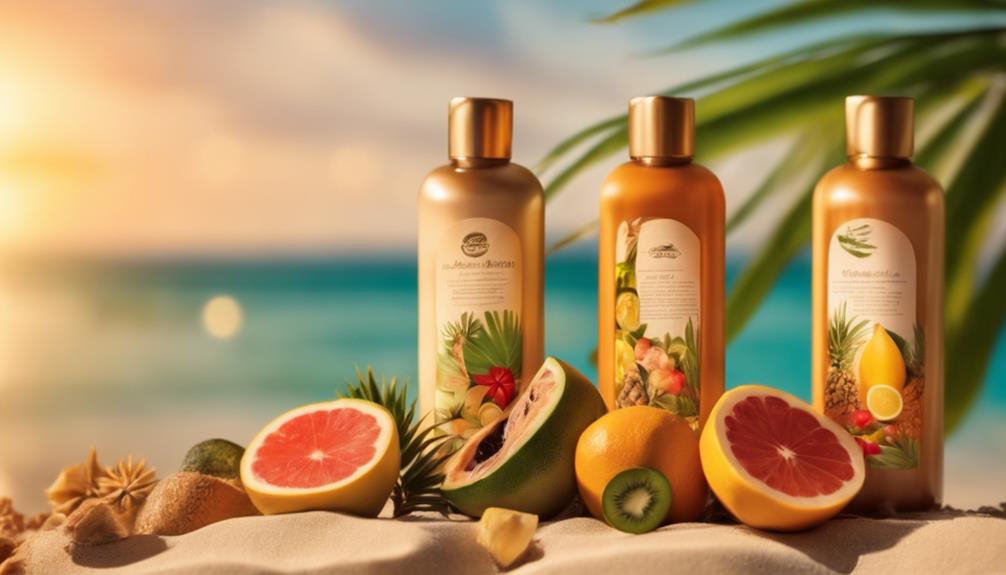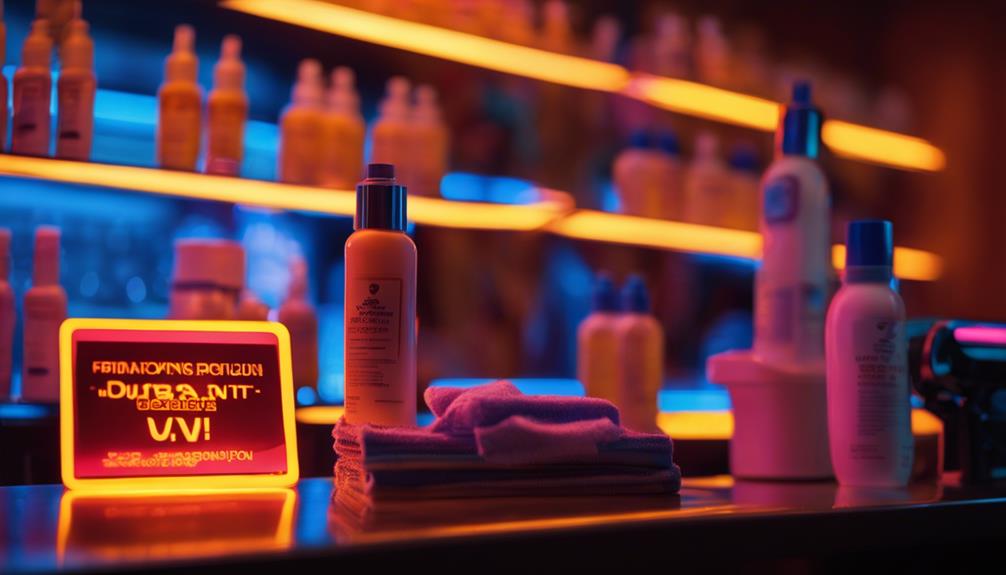Releasing the ideal tanning lotion shade for your skin tone and undertones is essential. Fair skin requires subtle tanners, while medium or olive tones benefit from shades that enhance their natural warmth. To determine your undertones, check the color of your veins: blue indicates cool undertones, while green signals warmth. It is important to choose products wisely; gradual tanners are ideal for lighter skins, while darker shades complement medium tones. Remember to carefully assess product quality and ingredients for the best results. Taking a knowledgeable approach not only helps with selecting the right shade but also ensures a natural glow. Stay tuned to uncover more tips and tricks for achieving the perfect tan!
Key Takeaways
- Identify your skin tone (fair, light, medium, or dark) to choose an appropriately tinted tanning lotion.
- Determine your undertones by checking vein color; this helps in selecting complementary shades.
- Opt for gradual tanners if you have fair/light skin for a subtle, natural glow.
- Evaluate product ingredients for hydration and avoid those that clog pores or irritate skin.
Assess Your Skin Tone
To choose the right tanning lotion, start by evaluating your skin tone and undertones, as this will help you find the perfect shade for a natural-looking glow.
Fair skin often has freckles and pink undertones, so opt for subtle tanners.
If you have light skin, determine whether your undertones are warm or neutral and select tanners that enhance your natural shade.
Medium or olive skin tones thrive with tanners that complement their warmth.
For dark skin, look for products that provide a subtle glow and enhance your rich complexion.
Understanding your skin tone will guide you in selecting the best tanning products, ensuring your tan looks radiant and authentic.
Always test a small area first to see how the product reacts with your skin.
Identify Undertones
Identifying your undertones is essential for selecting the perfect tanning lotion that complements your skin tone.
To do this, check the color of the veins on your wrist. If they appear blue or purple, you likely have cool undertones. Green veins indicate warm undertones, while a mix of both suggests neutral undertones.
Understanding your undertones helps you choose a tanning lotion that enhances your natural glow rather than clashing with your complexion.
For cool undertones, look for products with a hint of ash or violet, while warm undertones pair well with golden or bronze shades.
Neutral undertones can pull off a range of colors, making it easier to find your ideal match.
Select the Right Product

Once you've determined your undertones, selecting the right tanning product becomes much easier.
For fair or light skin, opt for gradual tanners that subtly build color. If you have medium skin, look for darker shades that enhance your natural warmth.
Don't forget to take into account the product type—lotions, mousses, and drops each offer unique application experiences. Starting with a lighter shade lets you gradually achieve your desired look without going overboard.
Aloe vera-infused options are great for hydration while delivering a beautiful glow.
Don't hesitate to experiment with different products to find your perfect match. Remember, the right tanning lotion should complement your skin tone and enhance your overall appearance.
Happy tanning!
Determine Desired Tan Intensity
Determining how intense you want your tan is essential to selecting the right tanning product that fits your goals. Start by evaluating your natural skin tone and set realistic expectations.
If you're aiming for a sun-kissed glow, a subtle shade works best. For a deeper bronze, consider medium to dark tanners.
Always remember, a gradual approach is recommended; it helps you avoid any drastic changes that might look unnatural. Test out lighter shades first, allowing your tan to build over time.
This way, you can achieve the desired intensity without risking an overly dark appearance. Ultimately, the goal is to enhance your natural beauty while enjoying a radiant, healthy-looking tan.
Evaluate Product Quality

When evaluating a tanning product, focus on its ingredients and user reviews to guarantee you choose one that meets your needs and expectations.
Look for feedback from users with similar skin tones, as this can provide insight into effectiveness and finish. Pay attention to comments about the scent; a pleasant aroma can enhance your tanning experience.
Additionally, investigate the product's durability and longevity to make sure your tan lasts. Aim for products that promote a natural look rather than an artificial finish.
Review ingredient lists for beneficial components like aloe vera and Vitamin E, while avoiding any pore-clogging or irritating substances.
Understand Ingredients
Understanding the ingredients in tanning lotions is essential for ensuring you choose a product that's both effective and safe for your skin.
Look for key components like aloe vera and Vitamin E, which provide hydration and nourishment. These ingredients help maintain your skin's health while achieving that desired glow.
Avoid products with pore-clogging or irritating substances, as these can lead to breakouts or rashes.
Also, consider formulations that include SPF for added protection during sun exposure.
Pay attention to the scent; a pleasant aroma can make application more enjoyable.
Consult Professionals for Guidance

Consulting skincare professionals can provide valuable insights tailored to your unique tanning needs. They can help you choose the right shade based on your skin tone and undertones. Additionally, they offer application tips to prevent streaks and patches, ensuring a flawless look.
| Expert Guidance | Benefits |
|---|---|
| Personalized shade matching | Ideal tanning results |
| Tips for sensitive skin | Avoid irritation |
| Product recommendations | Informed choices |
| Application techniques | Smooth, even finish |
What Are the Best Tanning Lotions for Achieving the Perfect Tan Shade?
Looking for the top tanning lotions to achieve the perfect tan shade? Consider checking out products with added bronzers or accelerators for a deeper, more even tan. Many tanning lotions also include moisturizing ingredients to keep your skin healthy and glowing. Make sure to choose a product suited for your skin type.
Conclusion
By understanding your skin tone and undertones, you can confidently choose the perfect tanning lotion that complements your unique complexion.
For instance, if you have fair skin with cool undertones, a lightweight gradual tanner can give you that subtle glow without looking orange.
Remember, selecting the right product and intensity is key to achieving that natural, sun-kissed look you desire.
So, take the plunge and embrace your ideal bronzed skin with the right choices!










